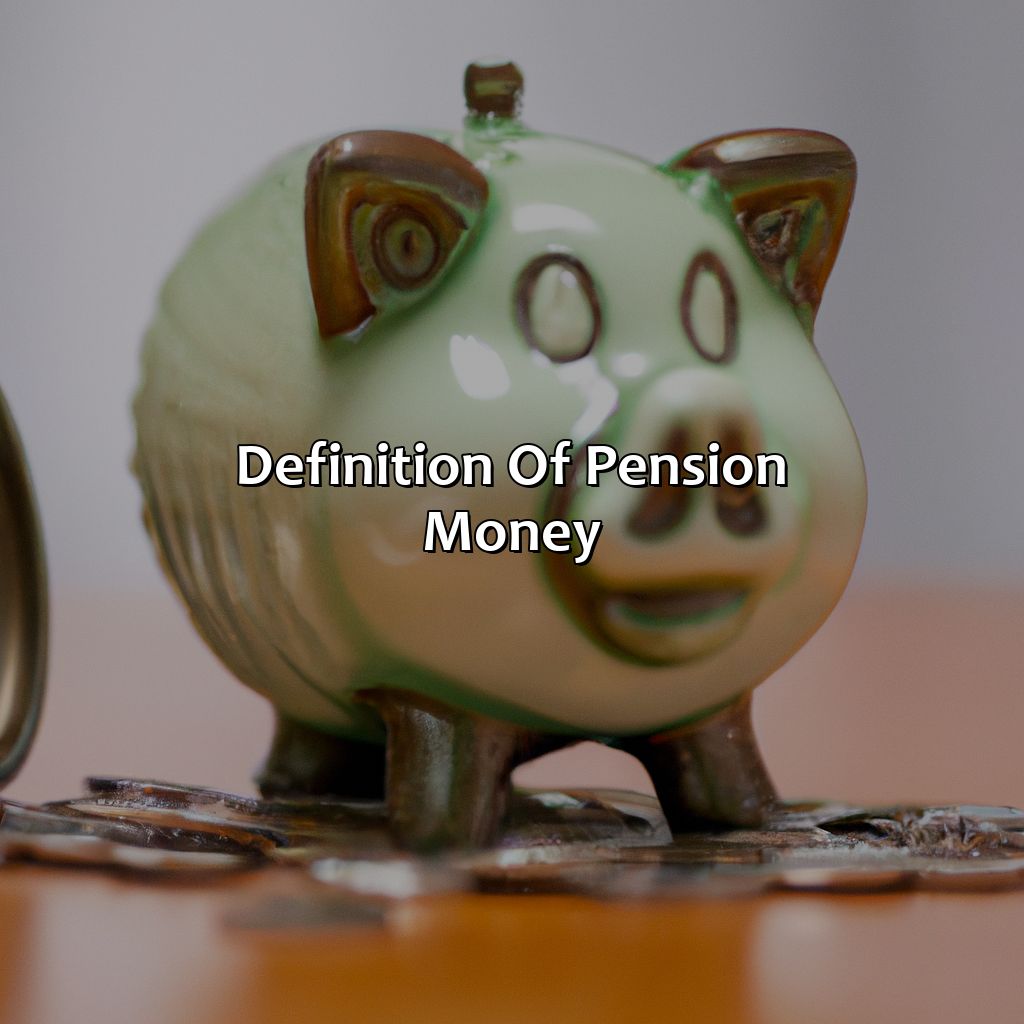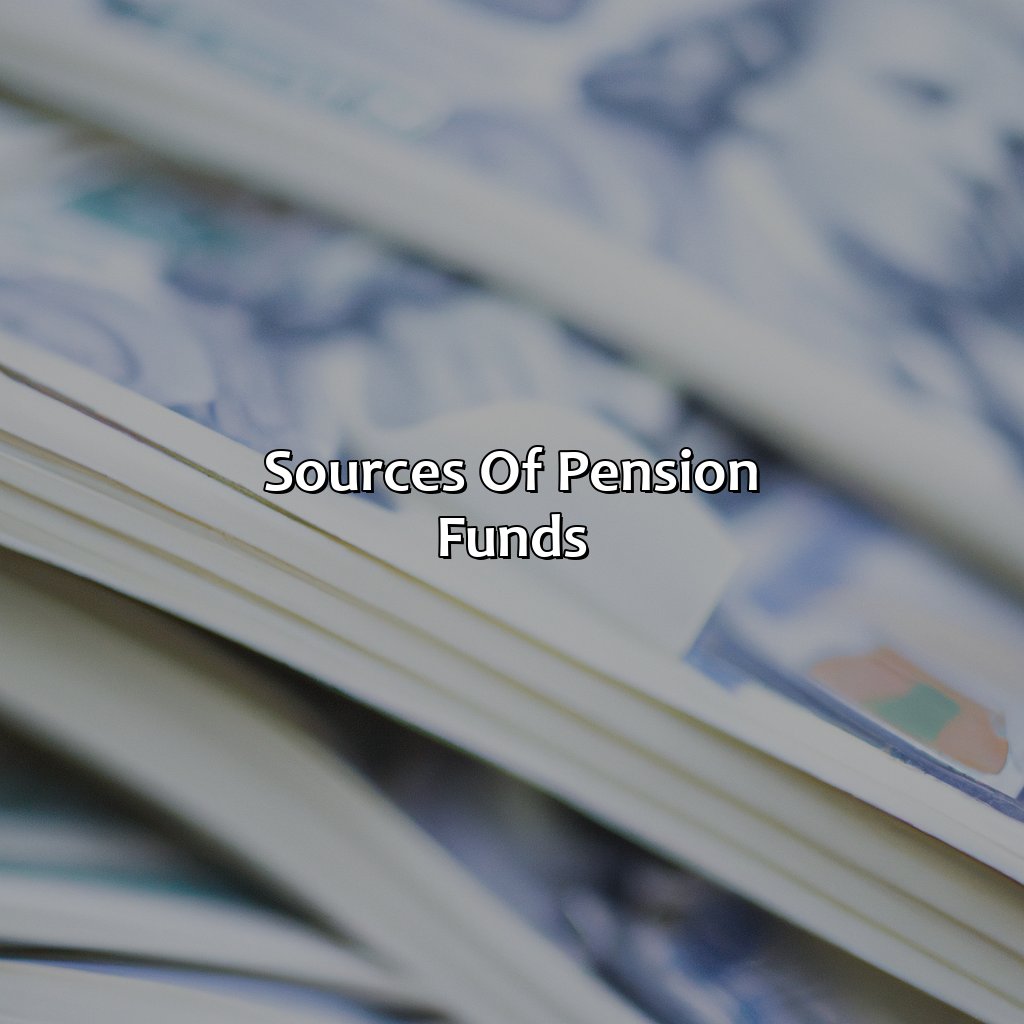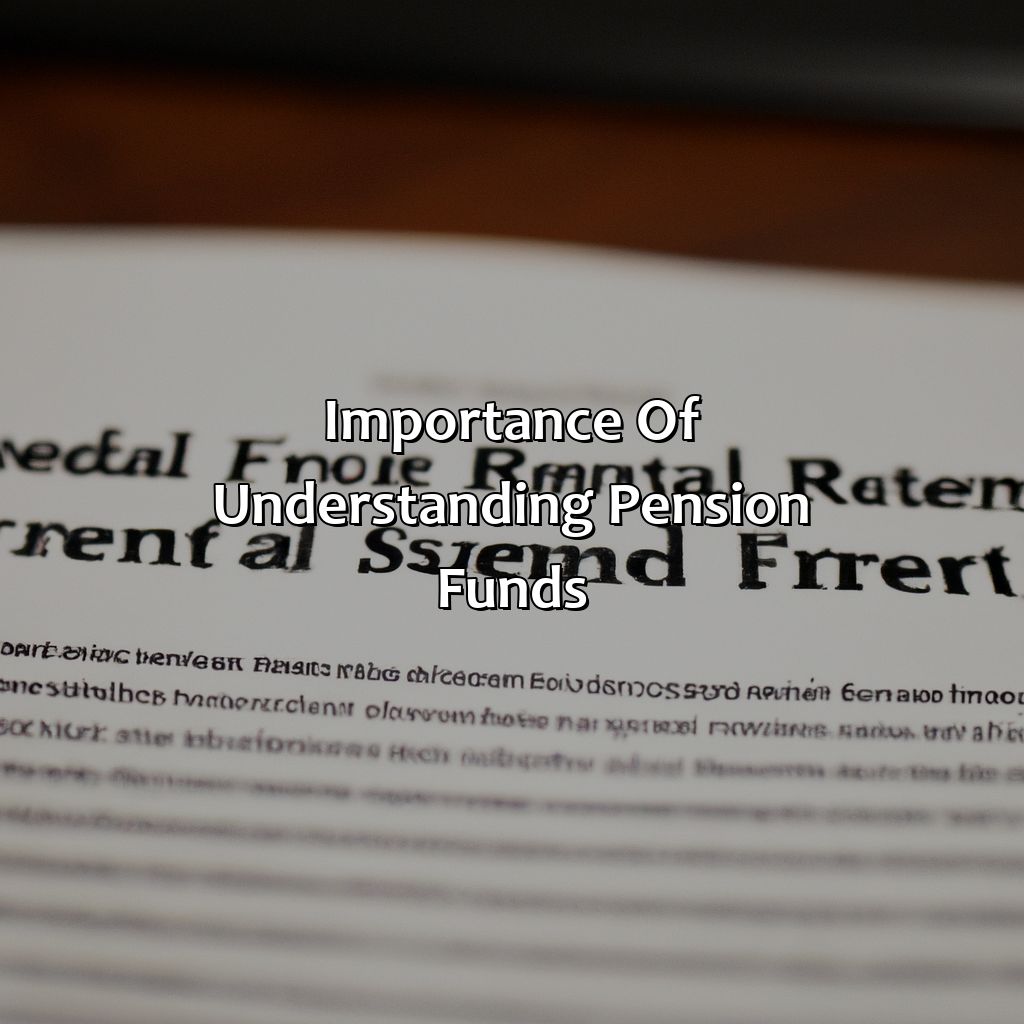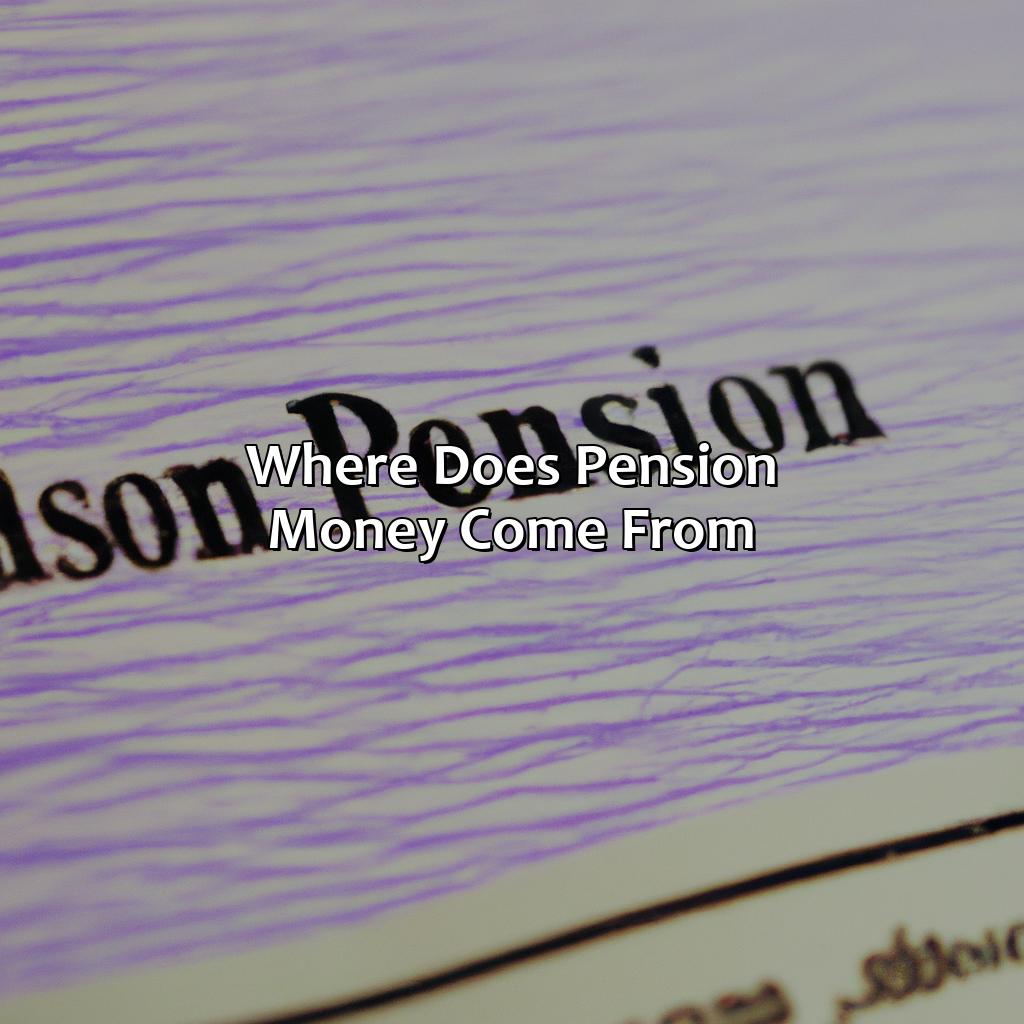Where Does Pension Money Come From?
Key Takeaway:
- Pension money is a sum of money paid to an individual based on their retirement from work. Pension funds are typically sourced from government pension plans, employer-sponsored pension plans, and individual retirement plans.
- Government pension plans are funded by contributions from eligible employees and employers, as well as earnings generated from past contributions. Employer-sponsored pension plans are funded by contributions from employers, employees, and earnings generated from investments. Individual retirement plans are funded by individual contributions that are either tax-deductible or tax-free.
- Pension funds are usually invested in a mix of stocks, bonds, and other investments. While this can result in higher returns, there is also an associated risk and it is important for individuals to understand the investment strategy and how it translates to their retirement income.
Are you worried about your pension money? You don t have to be. In this blog, we’ll explain where pension money comes from, so you can rest easy and secure your future.
Definition of Pension Money
Pension funds are a crucial financial instrument that provides retirement income to employees. These funds are investments made by employees and employers during their working years for the provision of an income stream after retirement. The money pooled in these funds is then invested in stocks, bonds, and other financial vehicles to earn returns over time. An employee’s pension contributions may be mandatory or voluntary, and the employer may also match this amount.
Studies show that pension funds are one of the most significant sources of investment capital. Pension funds invest massive amounts of money in the market, leading to job creation and economic growth. Governments and other institutions also generate pension funds to promote retirement security.
It is important to note that the management of pension funds is subject to government regulations and oversight to ensure that these funds are invested prudently to minimize risks. Inaccurate investment strategies or errors in financial forecasts can significantly impact the stability of these funds.
Pro Tip: It is essential to start saving for retirement early. The earlier you start, the more time your investments have to grow, and the easier it will be to sustain your retirement income stream.

Image credits: retiregenz.com by David Arnold
Sources of Pension Funds
Understand pension fund sources better! Retirement planning is more important now. So, know where your money can come from. Check out the pros of government pension plans, employer-sponsored ones, and individual retirement plans.

Image credits: retiregenz.com by Joel Woodhock
Government Pension Plans
Government-run Pension Programs are an important source of retirement funds. They comprise funds such as Social Security, funded by taxes, and the Civil Service Retirement System (CSRS), which collects contributions from employees and employers. These plans ensure citizens’ financial stability upon retirement.
Many countries have government-run pension schemes to support their aging population. If you’re wondering how to find your pension information, it’s important to note that the Canadian Pension Plan (CPP) is funded by employee and employer contributions while New Zealand’s Superannuation Fund is funded by government contributions. Similarly, the Indian National Pension System (NPS) collects voluntary contributions from employees and employers.
It is noteworthy that government pension programs are designed to provide basic retirement income security to all eligible residents. One example of this program’s effectiveness can be traced back to Sweden where in 1999 it launched a reform that required individuals to invest in private accounts within the national pension system the result showed a positive impact on taxpayer finances.
Looking forward to your retirement? Just hope your employer is more committed to funding your pension plan than they are to their weekly office pizza party.
Employer Sponsored Pension Plans
Employer-sponsored retirement plans are commonly known as Company Pension plans, which are a form of deferred compensation. These plans are established by employers to provide their employees with benefits after their tenure.
- Employers offer these pension plans as an incentive to retain talented employees.
- Retirement coverage is provided through various types of pension plans, including defined benefit, defined contribution, and hybrid retirement plans like cash balance and pension equity.
- These plans usually receive contributions from both the employee and employer.
It is pertinent to mention that Employers offer a wide range of investment options in retirement accounts under company-sponsored pension plans such as mutual funds, stocks, and bonds.
Traditional workplace pensions were once prevalent in most countries across the globe, but after the 2008 financial crisis, more focus shifted from traditional pensions to modern systems. Nowadays companies primarily offer defined contribution schemes where individual retirements rely on economic growth and market efficiency at the time of withdrawals.
In a real-life scenario, Emily works for a multinational corporation that provides her with an employer-sponsored 401(k) plan. Under this plan, Emily can contribute up to $20k per year or 100% three-month salary under automatic enrolment where employers match 50% of contributions- allowing her to reap financial rewards while planning for her retired life.
If you want to know more about what is the pension supplement, you can explore our website for more information.
Retiring with a plan is always a good idea- unless your plan is to win the lottery.
Individual Retirement Plans
For retirement planning, individuals can opt for personalized pension plans. A single individual can set aside money for their future with either a defined benefit or a defined contribution plan. The former guarantees an amount of money upon retirement based on factors such as age and salary, while the latter involves regular contributions towards a retirement account that may be invested in stocks or bonds.
Such plans come with various regulations to ensure the financial security of participants. For example, contributions are tax-deductible up to certain limits and withdrawals are subject to age restrictions and penalties. Planning ahead and staying informed about relevant laws can maximize returns and minimize costs. It is important to understand what ER pension is and where pension money comes from.
Some retirement plans offer additional benefits such as long-term care insurance or estate planning services. Consulting a financial advisor can help determine which plan best suits one’s needs and goals, taking into account factors like health, lifespan, income level, and investment risk tolerance.
Pro Tip: When selecting an individual retirement plan, consider diversifying your investments across different asset classes to balance risks and returns over time. Find out more about how many pension plans are there in the US.
Who knew retirement planning could be as risky as playing roulette? Welcome to the high-stakes world of pension fund investments.
How Pension Funds are Invested
Do you want to know how your pension funds are invested? Check out the section on ‘How Pension Funds are Invested‘. It explains a few things, like Types of Investments, Investment Risks, and Impact on Retirement Income.
Discover the different investment types pension funds make. Learn about the risks that could be involved. Understand how these investments affect your retirement income.

Image credits: retiregenz.com by Adam Washington
Types of Investments
Investment Opportunities for Pension Funds
Pension funds invest in various financial instruments to diversify their portfolios and generate returns. Here’s how they are categorized:
- Equities: Stocks of public companies
- Bonds: Fixed-income securities issued by governments and corporations
- Real estate: Tangible assets that include property, buildings, and infrastructure
- Alternative investments: Assets such as private equity, hedge funds, commodities, and infrastructure projects
Pension funds may also allocate assets to other investment vehicles like mutual funds or exchange-traded funds (ETFs). These types of investments are made to minimize risk while achieving maximum returns on investment.
Pension funds’ investment strategies differ based on the plan type, funding levels, regulations, and the fund’s goals. Still, their primary objective is to preserve member benefits. If you’re wondering how does a pension fund work, it’s important to understand its investment strategies and goals.
Pro Tip: A well-diversified portfolio that balances risk with rewards is crucial for maximizing returns while minimizing exposure.
Put your retirement money in the hands of Wall Street and hope for the best – what could possibly go wrong?
Investment Risks
Investment Exposure:
One crucial aspect that every pension fund invests in is the investment exposure or the amount of risk they are willing to take. Pension funds face various risks such as market volatility, credit risks, geopolitical risks, and inflation risk. Pension funds must manage their investments while maintaining a balance between earning returns and managing potential losses.
Asset Allocation:
Another significant factor to consider is asset allocation. If you are wondering what is a pension, pension funds use asset allocation strategies based on their investment objectives, risk tolerance, time horizon, and liquidity needs. The pension fund managers typically allocate assets across various investment classes such as equities, fixed income securities, real estate, infrastructure projects, private equity, hedge funds, commodities and other types of alternative investments.
Risk Management:
To mitigate the risks involved in pension fund investments, pension fund managers use sophisticated portfolio management techniques such as diversification and hedging. Diversifying the portfolio by investing across a variety of assets can help limit the impact of any single investment’s underperformance while hedging involves taking an opposite position in another instrument to offset potential losses from a particular asset.
Regulatory Compliance:
The pension industry is heavily regulated with strict compliance requirements pertaining to asset allocation rules and disclosure procedures. As such, it is imperative that pension funds comply with all regulatory requirements so as not to incur penalties or fines. If you are wondering what is EE pension, it is a type of pension plan where the employee and employer each contribute to the plan. The contributions are deducted from the employee’s salary and invested in the plan, with the goal of providing retirement income.
To ensure positive outcomes for both employers and employees alike in relation to pensions – Investment exposure demands strict attention whether a strategy focuses on achieving long-term growth or maintaining short-term gains through proper risk management techniques combined with smart asset allocation policies.
Retirement income: the only time you’ll wish your investments were as boring as beige paint.
Impact on Retirement Income
The way pension funds are managed can significantly impact the retirement income of individuals. The investment decisions made by fund managers can determine whether retirees have enough money to sustain their lifestyle. Pension funds come from a variety of sources, such as employer contributions, personal contributions, and government contributions.
It is essential to consider the long-term impacts that investment decisions can have on retirement income. Investing in high-risk assets may yield higher returns in the short-term but could lead to losses in the long run and affect S pension negatively. On the other hand, investing in low-risk assets may offer stable returns but may not keep up with inflation rates.
To ensure a steady stream of income after retirement, individuals should select savings plans carefully. Diversifying investments across various assets can help mitigate risks and generate better returns for long periods.
In summary, making strategic investment decisions plays a crucial role in determining the amount of money one will receive during retirement. Careful consideration of different investment types and consistent monitoring is required to ensure adequate financial support for post-retirement years.
Understanding pension funds is like understanding your ex’s new relationship – it may be complicated, but it’s important to know where your money is going.
Importance of Understanding Pension Funds
Pension funds are crucial for securing a financially stable future post-retirement. Therefore, comprehending where the pension money comes from is vital for individuals. The origin of pension money typically lies in contributions from employers, employees, and the government, invested in a pool of securities and assets.
Understanding pension funds is essential for people as it directly impacts their retirement security. With pension funds, individuals can accumulate savings over time, which can serve as a source of income in retirement. It is crucial to know the benefits and potential risks associated with pension funds, as well as the investment strategies of fund managers.
For those wondering which of the following IRAs provides a pension for employees, click here for more information.
One key detail to note is that pension funds are long-term investments, and the money invested is managed by professional fund managers. Pension funds primarily invest in a diversified portfolio of securities, such as stocks, bonds, and real estate. An important aspect of understanding pension funds is to be aware of the investments made, their risks, and the potential returns.
To ensure a stable and secure retirement, individuals should take an active interest in their pension funds. They can do this by regularly checking their account balances, reviewing investment strategies, and monitoring investment performance. It is also essential to contribute regularly to pension funds and seek expert financial advice when necessary.

Image credits: retiregenz.com by Harry Jones
Some Facts About Where Pension Money Comes From:
Pension money can come from a variety of sources, including employer contributions, employee contributions, and government subsidies. (Source: Investopedia)
Pension plans can be either defined-benefit plans, which guarantee a specific payout to retirees, or defined-contribution plans, which only guarantee a specific contribution by employers and employees. (Source: The Balance)
State and local governments are the largest sponsors of defined-benefit pension plans, while private employers are more likely to offer defined-contribution plans. (Source: Pew Charitable Trusts)
Pension funds generally invest in a mix of stocks, bonds, and other assets to generate returns that can be used to pay retirees. (Source: Forbes)
The funding status of pension plans can vary widely, with some plans being fully funded, while others may have significant funding shortfalls. (Source: Pension Rights Center)
FAQs about Where Does Pension Money Come From?
Where does pension money come from?
Pension money comes from a variety of sources, including employer contributions, employee contributions, and investment returns from the pension fund.
Do all employers offer a pension plan?
No, not all employers offer a pension plan. It is up to the employer to decide whether or not they want to offer a pension plan as a benefit to their employees.
What happens to the pension money if the employer goes bankrupt?
If an employer goes bankrupt, the pension money is typically protected by the Pension Benefit Guaranty Corporation (PBGC), a federal agency that provides insurance for private-sector pension plans.
What is the difference between a defined contribution plan and a defined benefit plan?
A defined contribution plan is a retirement plan in which both the employer and employee make contributions to an individual account, and the employee bears the risk of investment returns. A defined benefit plan is a retirement plan in which the employer promises to pay a specific benefit amount to the employee at retirement, and the employer bears the investment risk.
Can pension money be withdrawn before retirement age?
In most cases, pension money cannot be withdrawn before retirement age without incurring penalties. However, some pension plans may allow for hardship withdrawals or loans in certain situations.
What happens to the pension money if the employee dies before retirement age?
If an employee dies before retirement age, the pension money may be passed on to their designated beneficiary or estate, depending on the specific terms of the pension plan.
 Checkout this IRS Loophole
Checkout this IRS Loophole 
